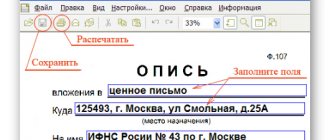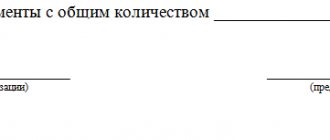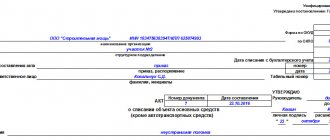Inventory list of goods and materials
The inventory list of goods and materials, form INV-3, was approved by Decree of the State Statistics Committee of August 18, 1998 No. 88. Registration of INV-3 is necessary for the purpose of recording the actual availability of inventory in a particular organization. In this case, goods and materials mean:
- goods;
- finished products;
- production or other inventories of the company, etc.
Valuables may be stored in specially designated places (warehouses, boxes, hangars, etc.) or be at any stage of movement in connection with the activities of a legal entity. Thus, the information entered into the INV-3 form is determined during the ongoing procedures of recalculation, weighing, and measurement exclusively at the location of the inventory items.
Mandatory details of INV-3
When using a unified inventory form during an inventory, employees of the inspection commission need to know what mandatory details must be filled out. The INV-3 inventory list must contain:
Page 1 of the inventory - receipt
Filling out the inventory begins with entering the required details into the receipt:
- In the fields “Organization” and “Structural unit” the full or abbreviated corporate name of the organization is entered in accordance with its constituent documents.
If the staffing table does not provide for division into structural departments of the company, the corresponding field remains blank. - As the basis for conducting an inventory, an internal administrative document of the executive body of the company (resolution, order, instruction), the date of its preparation and registration number are indicated. Unnecessary document names must be crossed out.
The frequency of inventory is determined by the management of a particular legal entity. The inspection can be scheduled or carried out urgently. Inventory records of inventory items during a planned inventory are no different in form and content from those compiled during an unplanned inspection.
- In the fields “Inventory start date” and “Inventory end date”, calendar designations corresponding to the time of inventory actions are entered.
- The document number and date of its preparation are filled in in accordance with the organization’s current policy for maintaining and recording internal document flow.
- In the column “Type of inventory assets” the name of the goods or other industrial products subject to accounting is indicated.
- The next ordinal field must contain information about the type of ownership on the basis of which the legal entity. a person uses or disposes of goods and materials - ownership, rent, storage, processing, etc.
- The positions and personal data of employees who are entrusted with the responsibility for maintaining records and taking inventory of valuables are indicated as financially responsible persons. Such an obligation may be provided for in an employment contract, order, regulation, agreement on the assignment of duties to ensure the safety of inventory items, job description, etc.
- At the end of the receipt, the actual date of removal of the remaining goods is indicated.
INV-3: sample of filling out 2-4 pages of inventory
The inventory list of inventory items (pages 2, 3, 4) is presented in the form of a table, which includes the following information:
- numbers of accounts and subaccounts;
- name and information characterizing the inventory items;
- number of values, unit of measurement, item number;
- unit cost;
- information on the actually identified quantity of inventory items and on the reflected volumes according to accounting data.
The inventory list of inventory items in the final line is filled in, according to all information, figures and amounts, exclusively in words.
All members of the commission specially created for the inventory sign the inventory form. In addition, the inventory is certified by the signature or signatures of the employees financially responsible for the safety of valuables, and is also endorsed by the chief accountant, confirming the comparison operation.
How to draw up an inventory report
The procedure is carried out by decision of the head of the commission, the composition of which is necessarily approved by order. Moreover, the composition of such a commission, as a rule, is permanent. It includes representatives of the organization’s administration, accounting, economists, technicians, etc., incl. It is possible to involve independent audit organizations. The absence of at least one member of the commission during the inventory may be grounds to invalidate its results.
Depending on the purpose of the inventory, whether it is planned or unplanned, inventory acts can have different forms and contents: an inventory act of cash, an inventory act of shipped goods, etc. The form of each such act of approval by order of the Ministry of Finance of the Russian Federation. These forms are approximate, but very convenient for use.
The inventory report is drawn up in at least 2 copies; no erasures, corrections or blots are allowed. The actual availability of property is carried out exclusively with the participation of financially responsible persons, from whom explanations may be requested during the procedure.
The document must be signed by all members of the commission and the financially responsible person, who at the end of the inventory report gives a receipt indicating that there are no claims against the members of the commission.
Obligation to use the document
The use of a unified inventory form, starting from the beginning of 2013, is not the responsibility of business entities. In order to comply with the norms of the law on accounting, organizations can use an independently developed form for inventory of inventory items. A sample of a self-developed form must contain the mandatory details listed above. The exception is budgetary organizations, the obligation of which to use a unified inventory form is enshrined at the legislative level.
Before starting an inventory of goods and materials, the initiator of the inspection creates a special commission of employees of the organization. The inventory list of inventory items itself is compiled on paper in 2 copies: 1 is submitted to the accounting department for drawing up a matching sheet, 2 remains at the disposal of persons who are financially responsible.
If the commission identifies goods that are not taken into account by the accounting department, all data on such goods and materials are subject to mandatory reflection in the inventory list of inventories.
For materials related to material assets, but which have lost their properties for further use (spoiled or unsuitable for production), appropriate acts are drawn up.
Inventory card for accounting of fixed assets
An inventory card is a document that reflects information about all movements of a fixed asset. It is issued in the following situations:
- Any activity is carried out with the OS object (from the beginning of its registration);
- OS is moved within the organization, revalued, repaired, disposed of;
- The first entry in the card is made at the time of acceptance for registration or during introduction into use.
An inventory card for recording fixed assets allows you to solve many important problems, such as:
- Organizing information;
- Simplification of the analysis of OS information – for the company manager and other employees, as well as for inspection bodies;
- You can very quickly compile statistics about OS objects.
Necessary information to issue a card
An OS accounting card is created on the basis of an OS acceptance and transfer certificate. From the same document, some information about the purchased object is entered into it. Data from accompanying papers is also used.
A complete list of information required to correctly fill out the card is given below:
- Full name of the company;
- The name of a separate division, the OS of which is reflected in a particular case;
- Number and date of document generation;
- The object, as well as its main characteristics (date of construction, manufacturer, number and series);
- Codes for OKUD, OKOF and OKPO;
- Serial number, inventory number, depreciation group number, passport number;
- Date of acceptance for registration and date of deregistration;
- Account and subaccount;
- Analytical accounting code;
- The location where the OS object is located;
- Organization-manufacturer of the object;
- Information about the asset known at the time of its acceptance for accounting;
- Information about revaluation;
- Admission data;
- Information about changes in the original price;
- A short description and characteristics.
Procedure for filling out the card
The inventory card is filled out in the following order:
- Entering the necessary information into the card header - date of issue and card number in order.
- The accountant fills in the required details of the organization.
- The purpose of the structural unit is determined.
- The full name of the fixed asset accepted for accounting in the appropriate manner is indicated.
- Enter the number of the depreciation group to which the object belongs.
- The location of the OS object is determined.
- The first section is filled out - information about the object at the time of transfer is entered: production date, information about putting into use, service life, depreciation amount, residual value (only for objects that have already been in use).
- The second section is filled out - information about private investment and initial cost is recorded (this information is required for calculating depreciation).
- Section four is filled out - it indicates information about the acceptance of the object: details of the acceptance paper, the price of the object, as well as the full name and position of the responsible employee.
- Section seven is filled out - a brief description of the OS is written down.
- The third section is filled in only when a revaluation of an asset has occurred. The date of revaluation, conversion factor and replacement cost are indicated.
- The fifth section is filled out only if the original price of the property changes during modernization, reconstruction or liquidation.
- Section six includes information on the costs of repairing fixed assets.
After the card has been completely filled out, it is signed by the employee responsible for its storage and execution. In most cases, this employee is an accountant.
Card storage period
Inventory cards are primary reporting documentation. In this regard, standard rules apply to them. This means that after disposal of an object, they must be stored in the organization for at least five years. After this, the cards can be recycled.
Inventory of cards
An inventory of inventory cards is a mandatory procedure for organizations that must be carried out every few years. The main purpose of this is to register the IP.
This procedure will help ensure that all documents are safe and sound. Registration must be carried out in full accordance with the accounting budget accounts.
When disposing of an asset, the following information must be reflected:
- Date of operation – year, day and month;
- Serial number according to the transaction registration book.
Features of card design in budgetary organizations
There are nuances that are associated with accounting for property in budgetary institutions. To begin with, it is worth defining a list of situations when disposal of objects occurs:
- The donation occurs free of charge;
- The object became completely unusable;
- A shortage is identified - write-off is carried out at the expense of employees found guilty;
- Write-off of shortages due to natural disasters.
Upon disposal, the following documentation must be completed:
- Act on write-off of fixed assets (not drawn up for transport);
- An act of writing off an entire group of objects at once;
- Act on write-off of motor vehicles;
- The act of writing off soft and household equipment;
- The act of writing off library literature.
Similar articles
- Inventory card for accounting of fixed assets
- We draw up an inventory list - forms and samples
- Inventory list of intangible assets (sample)
- Inventory card for accounting of fixed assets
- Inventory list of intangible assets (sample)









